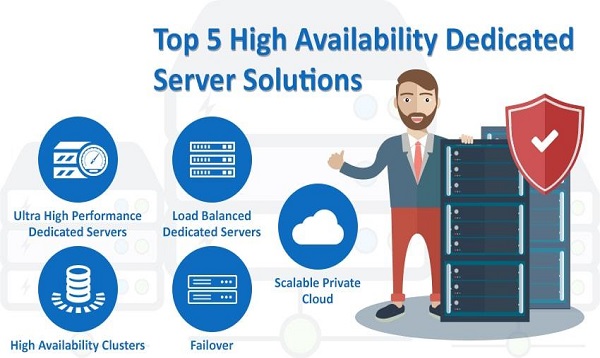High availability dedicated servers refer to highly powerful computers that enjoy high-speed web connectivity. These will also be typically housed within state-of-the-art data centers. Being advanced systems they are supported by redundant power connections, RAID disk towers, effective backup provisions etc so that clients get maximum reliability and a high uptime. When you have high-availability dedicated servers, you are not likely to experience any one point of failure.
The high-availability dedicated servers can be customized as these are scalable. So, you can configure them to cater to your own unique business interests. You can adjust the server settings so that critical applications never malfunction and remain available always. For businesses, these types of dedicated servers are found to be indispensable because even a few instances of downtime can be disastrous for any online venture. Besides huge revenue losses, companies are likely to experience a loss of face and their credibility gets damaged when there are frequent downtimes. If your buyers cannot access your site because of latency problems, they will navigate to other sites and the business ends up losing profits, time and buyer confidence. The results are even more disastrous at the time of peak seasons. So, the only way to avoid such instances of revenue losses for businesses is to choose high-availability servers. These systems will work on the basis on a complex set-up of software and hardware where each component is capable of functioning on its own.
This will ensure that even if there is a glitch in any one component, the entire system will never collapse. Here are 5 high availability dedicated servers for businesses:
1. The ultra-high performance servers refer to the high-end dedicated servers having very high computing strength. These have been designed to get superior site performance and therefore are best suited for enterprise-level workloads. These servers will typically comprise of the latest dual Intel Xeon E5 or E3 series processors, 64GB-256 GB RAM redundant power connections, cooling units, 8-24 TB SATA II HDD, and offsite backups. In case additional power is required, it is possible to upgrade the capacity.
2. Load balancing dedicated servers are another type of high-availability servers. These will ensure that the incoming traffic is evenly and effectively distributed amongst many servers without any instances of disruptions. The load balancer is the software which is designed to offer the load balancing advantage. This load balancer is responsible for directing user requests to different servers. So, it will ensure that requests get fulfilled in such a manner which guarantees the highest speed and proper capacity usage of all the servers. In short, no server remains underutilized or over-utilized. So, every time buyers visit a website, they get connected to load balancers first and these route them to the servers. When any of the servers malfunction, this software ensures that the traffic gets re-routed to other active servers on standby. When there is more traffic, you are free to add new servers too.
3. A scalable private cloud refers to a cloud computing model where you can enjoy self-service, elasticity and a high degree of scalability. A private cloud is scalable because you can get resources you need when you need these. So, you are free to upgrade your storage area or memory or processing power at any time. Moreover, the private cloud is also highly secure making it perfect for large companies. You are free to customize storage and networking to cater to your specific business needs. Data gets stored in dedicated servers which can be accessed by you alone. When you have the servers on-site, there is an internal staff to monitor them; when the servers are housed in data centers, there are experts to monitor these. Besides, the private cloud offers the highest levels of redundancy so that you do not need to buy additional hardware when traffic peaks. You enjoy better control over both the infrastructure and data as your business gets access to the server resources exclusively.
4. Fail over refers to the power to switch to standby servers and networks when the main network or server fails for some reason. This may be due to maintenance reasons and workloads will be automatically shifted to secondary networks. However, the fail over needs to be smooth so that users do not even get to know about it. So, this is a perfect solution for businesses to prevent downtime at any cost. Automatic fail overs are easy to install. There are primary and secondary servers, both with the same data. A third server monitors the main server so that when there is a problem, it updates DNS records for the site and ensures that traffic gets re-routed to the standby server.
5. High availability clusters refers to a server group which can support server applications so that there is least downtime whenever any server fails because of overloading. The most widely prevalent clusters are active-passive and active-active. The first has dual nodes but not all are active at the same time. The secondary stays passive and this type is suited for failover clusters environments. The latter has dual active nodes and is best suited for true load balancing. This solution ensures that even if any server in a cluster tends to go offline, services will get migrated to the active host. The faster the server can be restored online; the faster your business recovers.
Read More at : Types of Web Hosting Solutions for Businesses






 Live Chat
Live Chat